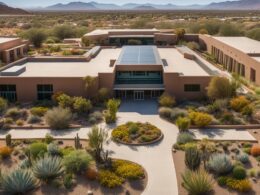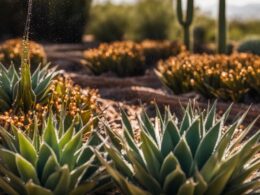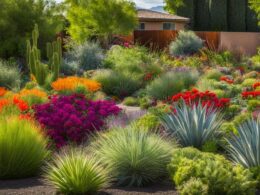Native perennials are an ideal choice for water conservation in gardens across the United States. By incorporating these plants into your landscape, you can contribute to preserving water resources while enhancing the beauty of your garden. The following lists of native plants for different categories will provide you with a variety of options to choose from. These lists are based on regional gardens and recommendations from experts in the Mid-Atlantic region.
Key Takeaways:
- Native perennials are a great option for water conservation in the US.
- By using native plants, you can help preserve water resources and support local ecosystems.
- Consider incorporating native wetland plants, plants for critters, wildflowers, and shrubs into your garden.
- Native plants are adapted to local climates and conditions, making them resilient and suitable for various growing environments.
- Selecting native plants can create a sustainable and vibrant garden while attracting wildlife.
10 Native Wetland Plants
Wetland areas can provide a serene and calming ambiance to your garden. If you’re looking to create a water garden or enhance the aesthetics of your landscape, incorporating native wetland plants is a fantastic idea. These plants are specifically adapted to thrive in moist environments and can add beauty and functionality to your outdoor space. Here are ten native wetland plants to consider:
Bulrush (Schoenoplectus spp.)
Bulrush, also known as tule or cattail, is a versatile wetland plant that can be found in various regions. Its tall, reed-like stems and distinctive brown seed heads add visual interest to any water garden.
Marsh Marigold (Caltha palustris)
The bright yellow flowers of marsh marigold bloom in early spring, adding a cheerful touch to wetland areas. This plant thrives in partially shaded spots and can be a lovely addition to ponds or the edges of streams.
Swamp Milkweed (Asclepias incarnata)
Swamp milkweed is not only visually appealing with its pink or mauve flowers, but it also attracts butterflies and other pollinators. This plant can thrive in a variety of soil types and is an excellent choice for wetland gardens.
| Plant | Description | Height | Preferred Sunlight |
|---|---|---|---|
| Bulrush (Schoenoplectus spp.) | Versatile wetland plant with tall, reed-like stems and distinctive brown seed heads. | 3-10 feet | Full sun to part shade |
| Marsh Marigold (Caltha palustris) | Early spring bloomer with bright yellow flowers, perfect for ponds and streams. | 8-24 inches | Part shade to full sun |
| Swamp Milkweed (Asclepias incarnata) | Visually appealing plant with pink or mauve flowers that attract butterflies. | 3-5 feet | Full sun to part shade |
| Pickerelweed (Pontederia cordata) | Beautiful blue or violet flowers on tall spikes, ideal for ponds and water features. | 3-5 feet | Full sun |
| Blue Flag Iris (Iris versicolor) | Delicate blue or purple flowers on tall, sword-like foliage, suitable for pond edges or marshy areas. | 2-3 feet | Full sun to part shade |
| Cardinal Flower (Lobelia cardinalis) | Stunning red flowers that attract hummingbirds, perfect for wetland gardens. | 2-4 feet | Full sun to part shade |
| Joe Pye Weed (Eutrochium maculatum) | Tall plant with clusters of pink or mauve flowers, a favorite of butterflies. | 4-7 feet | Full sun to part shade |
| Marsh Hibiscus (Hibiscus moscheutos) | Large, showy flowers in various colors such as pink, white, or red, perfect for wetland gardens. | 3-7 feet | Full sun to part shade |
| Blue Vervain (Verbena hastata) | Tall spikes of purple flowers that attract butterflies and other pollinators. | 3-5 feet | Full sun to part shade |
| Cattail (Typha spp.) | Iconic wetland plant with tall, cylindrical seed heads and long, flat leaves. | 3-9 feet | Full sun to part shade |
Native wetland plants not only bring beauty to your garden but also contribute to the preservation of local ecosystems. By selecting these plants, you create a habitat for beneficial insects, birds, and other wildlife. They are well-adapted to wet environments, ensuring their resilience and long-term survival. Consider incorporating these native wetland plants into your garden and enjoy the benefits of a vibrant and sustainable landscape.
By planting native wetland plants, you can create a thriving water garden while supporting local biodiversity. These plants offer a range of colors, heights, and textures that can add variety and interest to your landscape. Whether you have a dedicated pond or a small water feature, these native wetland plants will provide a touch of natural beauty and attract beneficial wildlife. Explore the options available in your region and start transforming your garden into a picturesque wetland oasis.
10 Native Plants for Critters
Native plants are not only beneficial for the environment but also provide essential resources for local wildlife. By incorporating these plants into your garden, you can create a welcoming habitat for critters such as birds, butterflies, and bees. Here are ten native plants that can attract a variety of critters to your garden:
1. Black-Eyed Susan (Rudbeckia hirta)
The vibrant yellow flowers of the Black-Eyed Susan are a favorite among butterflies and bees. This native perennial blooms from summer to fall, providing a valuable source of nectar for pollinators.
2. Eastern Redbud (Cercis canadensis)
The Eastern Redbud is a small tree that produces beautiful pink flowers in early spring. These flowers attract bees and butterflies, while the tree’s seed pods provide food for birds and small mammals.
3. Joe Pye Weed (Eupatorium fistulosum)
Joe Pye Weed is a tall, herbaceous plant that produces clusters of pinkish-purple flowers. Butterflies and bees are particularly drawn to this plant, making it an excellent addition to a wildlife garden.
4. Wild Bergamot (Monarda fistulosa)
Wild Bergamot, also known as Bee Balm, has vibrant purple flowers that attract a wide range of pollinators. Its aromatic foliage also makes it a favorite among hummingbirds.
5. Coneflower (Echinacea purpurea)
Coneflower is a popular choice for wildlife gardens due to its distinctive purple petals and spiky center. Bees, butterflies, and birds, including finches, are commonly seen visiting these flowers.
6. Spicebush (Lindera benzoin)
Spicebush is a shrub that produces small yellow flowers in early spring, attracting butterflies and bees. Its red berries provide food for birds and small mammals during the fall and winter months.
7. Swamp Milkweed (Asclepias incarnata)
Swamp Milkweed is a native perennial with clusters of pink flowers that bloom in mid-summer. These flowers are a favorite among monarch butterflies and other pollinators.
8. Red Osier Dogwood (Cornus sericea)
Red Osier Dogwood is a shrub that features clusters of white flowers in spring and vibrant red stems in winter. These flowers provide nectar for pollinators, while the red berries attract birds.
9. Goldenrod (Solidago spp.)
Goldenrod is a late-blooming plant that produces clusters of yellow flowers. It is a valuable food source for bees and butterflies as they prepare for the colder months.
10. Butterfly Weed (Asclepias tuberosa)
Butterfly Weed is a bright orange perennial that attracts butterflies, including monarchs. Its nectar-rich flowers and foliage provide essential resources for pollinators.
By incorporating these native plants into your garden, you can create a vibrant and sustainable habitat for local critters. Remember to provide a variety of plant species, as different critters have different preferences. With these ten options, you can attract a diverse range of wildlife to your garden and contribute to their conservation.
10 Native Wildflowers
Native wildflowers are a vibrant and beautiful addition to any garden. These plants are not only aesthetically pleasing but also play a crucial role in supporting local ecosystems and attracting pollinators. Whether you have a sunny or shady spot in your garden, there are native wildflowers to suit different growing conditions. Here are ten native wildflowers that can add a splash of color and biodiversity to your landscape:
Table: Native Wildflowers
| Common Name | Scientific Name | Preferred Growing Conditions |
|---|---|---|
| Black-Eyed Susan | Rudbeckia hirta | Sun to part shade |
| Butterfly Weed | Asclepias tuberosa | Full sun |
| Coneflower | Echinacea spp. | Sun to part shade |
| Goldenrod | Solidago spp. | Sun to part shade |
| Blazing Star | Liatris spp. | Full sun |
| Cardinal Flower | Lobelia cardinalis | Part shade to shade |
| Wild Lupine | Lupinus perennis | Sun |
| Scarlet Beebalm | Monarda didyma | Part shade to shade |
| Indian Paintbrush | Castilleja spp. | Sun |
| Blue Flag Iris | Iris versicolor | Sun to part shade |
These native wildflowers are just a few examples of the many species available. Incorporating them into your garden not only adds beauty but also provides habitat for butterflies, bees, and other important pollinators. Remember to select wildflowers that are native to your specific region to ensure they are well-suited to the local climate and soil conditions.
To attract a variety of pollinators, consider planting a mix of wildflowers that bloom at different times throughout the growing season. This will provide a continuous source of nectar and pollen for bees and butterflies. Additionally, native wildflowers are generally low-maintenance and require less water and fertilizer compared to non-native species, making them an environmentally-friendly choice for your garden.
So, why not bring the beauty of native wildflowers to your garden? By choosing these plants, you can create a colorful and ecologically sound landscape that supports local wildlife and adds charm to your outdoor space.
10 Native Shrubs
Native shrubs are a versatile addition to any garden, providing both aesthetic beauty and functional benefits. These plants offer a range of colors, textures, and sizes, making them suitable for various landscape designs. Incorporating native shrubs into your garden not only adds visual interest but also supports local ecosystems and wildlife. Here are ten native shrubs that can enhance your landscape:
- Amelanchier laevis (Allegheny Serviceberry): This shrub features showy white flowers in the spring and edible berries in the summer. It is a valuable food source for birds and other wildlife.
- Clethra alnifolia (Sweet Pepperbush): Known for its fragrant white or pink flowers, this shrub attracts bees, butterflies, and hummingbirds. It thrives in moist or wet environments.
- Diervilla lonicera (Bush Honeysuckle): With its yellow flowers and attractive foliage, this shrub is a favorite among gardeners. It is also a host plant for the caterpillars of the spring azure butterfly.
- Hibiscus moscheutos (Rose Mallow): This shrub produces large, colorful flowers that attract butterflies and hummingbirds. It thrives in wet soil and can be a striking focal point in a garden.
- Ilex glabra (Inkberry): This evergreen shrub features dark green foliage and small black berries. It provides cover and food for birds and is suitable for wet or dry soil.
These are just a few examples of the native shrubs available for your garden. Before selecting shrubs, consider factors such as sunlight requirements, soil moisture levels, and the desired height and width of the plants. Consulting local gardening resources or nurseries can help you choose the best native shrubs for your specific location.
| Shrub | Height | Width | Sunlight | Soil |
|---|---|---|---|---|
| Amelanchier laevis | 15-25 ft | 10-15 ft | Full sun to part shade | Moist, well-drained |
| Clethra alnifolia | 3-8 ft | 3-6 ft | Full sun to part shade | Moist to wet |
| Diervilla lonicera | 2-4 ft | 2-4 ft | Full sun to part shade | Moist to dry |
| Hibiscus moscheutos | 3-7 ft | 3-6 ft | Full sun | Moist to wet |
| Ilex glabra | 3-6 ft | 3-6 ft | Full sun to part shade | Moist to wet, well-drained |
These native shrubs not only add visual appeal to your garden but also support local ecosystems by providing food and shelter for wildlife. By selecting the right shrubs for your specific growing conditions, you can create a sustainable and vibrant landscape. Incorporate native shrubs into your garden and enjoy the beauty and functionality they bring.
Native shrubs are a valuable addition to any garden. They provide beauty, support local ecosystems, and attract wildlife. By selecting the right native shrubs for your garden, you can create a sustainable and vibrant landscape. ” – Gardening Expert
How Can Native Perennials Help with Water Conservation in Low-Water Garden Design?
Incorporating native perennials in lowwater garden design strategies can significantly aid in water conservation. These plants are naturally adapted to local climate conditions, requiring minimal additional watering. By choosing these species for landscaping, homeowners can reduce water usage and contribute to sustainable gardening practices.
Conclusion
Incorporating native perennials for water conservation in your garden is a smart and eco-friendly choice. Not only does it help in preserving water resources, but it also adds beauty and vibrancy to your surroundings.
By selecting the appropriate native plants for wetlands, critter attractions, wildflowers, and shrubs, you can create a sustainable and diverse garden that supports local ecosystems and wildlife. Native perennials are specifically adapted to your region’s climate and conditions, making them resilient and easy to grow.
So, take the time to explore the native plant options available in your area. By doing so, you not only contribute to water conservation efforts but also create a stunning garden that brings joy to you and supports the environment. Start incorporating native perennials today and make a positive impact on the world around you.












